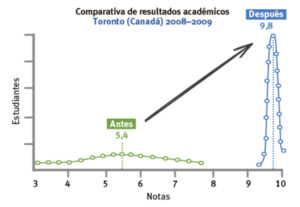How to increase confidence and self-esteem through mathematics
No children should feel like failures because they don’t understand mathematics. Like his character in the film The Untamed Will Hunting, John Mighton, the creator of JUMP Math, thought that “most people don’t realise how amazing it is”. When you aren’t taught mathematics properly and you stop understanding it, you end up thinking it’s your fault due to your lack of talent for the subject. This leads to a loss of self-confidence that increases as time goes on and extends to all the other subjects and every other aspect of the child’s life. A gap widens between the students’ academic performance and potential, one that’s more common among those from vulnerable backgrounds.
This mathematician, who also had to struggle with numbers, operations and formulas as a child, has always believed that everyone has the ability and potential to understand the subject well. He saw this in one of his first pupils, a primary school pupil he gave private tuition to after being warned that he was a hopeless case. The same boy is a Doctor in Mathematics today.
The above led to the creation of JUMP Math, a method whose name (Junior Undiscovered Math Prodigies) implies the firm conviction that it serves as a guide, based on the idea that children learn better when they feel admired and rewarded. His method, which also devotes particular attention to teachers and the way they teach their students, breaks down sophisticated mathematical concepts into very simple steps and fills the learning space with interaction and positive feedback. The vicious circle of self-esteem then becomes a virtuous circle; as girls and boys gain confidence in mathematics, they apply it to other skills, enhancing their confidence in their learnings and their lives.
The method: you can be as good as you dare to be
With JUMP Math teachers learn to teach mathematics differently and students learn to think differently too. Its approach is based on equality and it challenges the traditional teaching standards, creating an educational infrastructure that removes the assumption that there are natural hierarchies of ability – there are no particularly gifted or non-gifted people. This is a perverse belief that significantly restricts students’ learning and inevitably leads to failure.
JUMP Math offers students a sequenced and guided method, regardless of their theoretical intellectual capacity, enabling them to learn the concepts little by little. The complexity of the exercises is meticulously graded and the lessons are exhaustively planned and outlined from the very first minute to the last. The children work on the concepts in small steps, gradually discovering the subject, when they have the cognitive maturity required to understand them, eliminating any frustration and gaining self-confidence.
Thus, JUMP Math has had a huge impact on the self-perception of the children themselves, many of them with few resources and labelled as low achievers, and they immediately learn that they can be as good at maths as they dare to be.
Guiding those who guide: JUMP Math teachers
As we’ve already mentioned, JUMP Math isn’t a method aimed solely at the students. One of its basic objectives is to help teachers to learn to teach mathematics and enjoy doing so. JUMP Math is based on what’s called “guided discovery”; it’s the children who discover the concepts as they overcome the challenges presented to them. However, to achieve the above, the teacher has to know how to ask the questions properly, in a highly structured manner.
A lack of preparation and, on occasions, a lack of time often prevent the teachers, especially in primary education, from being able to plan their maths lessons properly. To make the task easier for them, JUMP Math has developed comprehensive guides that outline the course of the lessons practically by the minute. They also receive training that enables them to understand the approach and methodology and a support programme based on a community of teachers who exchange resources and pool practices, problems and solutions. In addition, the teachers are provided with materials to help them to build up the necessary confidence in the children.
Basic principles
What are the basic principles of this method?

-
- Ongoing and at-a-glance evaluation in the classroom.- To detect the different learning speeds and potential gaps in the graded learning.
- Guided discovery.- A balance between knowledge transmission and pure discovery engages the students and guides them towards acquiring key mathematical competences.
- Acquisition of confidence.- It energises the classroom in such a way that each and every one of the students gains the confidence required to discover, try and learn.
- Teacher-guided practice.- Acquiring and mastering concepts requires more practice than we’ve traditionally believed. JUMP Math is based on this practice being teacher-led.
- Rigorously paced instruction.- The lessons are divided into small, easily assimilated and ideally sequenced units, developed by Doctors in Mathematics and pedagogues who define the appropriate learning guidelines for each concept and skill.
- Mental calculation.- A skill that has been acquired in order to master more complex mathematical concepts in a streamlined manner.
- In-depth conceptual understanding.- To remove the learning of problem-solving mechanics that aren’t based on an understanding of concepts and procedures.
The students improve
Since its launch, JUMP Math has benefited more than 250,000 students who’ve seen their results improve substantially as they’ve lost their fear of the subject and begun enjoying it.
In 2011 a randomised control group study of 18 schools by the University of Toronto concluded that students that follow the JUMP Math programme learnt more and better than the control group, which used Canada’s most popular mathematics programme. Their knowledge improved twice as much as that of the control group.

Source: JUMP Math Spain
In the 2014-2015 academic year, a pilot test launched by the Telefónica Foundation was carried out in Spain; the evaluation by the Autonomous University of Barcelona concluded that there was a significant reduction in the number of fails at the schools that faithfully implement JUMP Math and an increase in the number of A and B grades. The rating improved by more than 2.1 points in the places where the programme has been applied the most.

Source: JUMP Math Spain
JUMP Math is a method that questions a deeply held belief in our society that “you either have or don’t have” mathematical talent and that, furthermore, those who have it are smart and those who don’t have it aren’t. John Mighton and his method have proved that this statement is not only false but also extremely harmful to students and society. We now know that everyone has a talent for learning and applying mathematics and that the likelihood of success in learning and using mathematics depends entirely on the way it’s introduced at an early age. Let’s heed the above, because it will determine whether we turn our children into young prodigies or firm candidates for failure at school.






